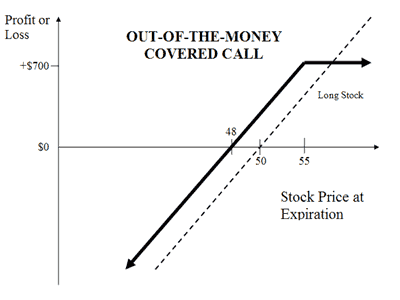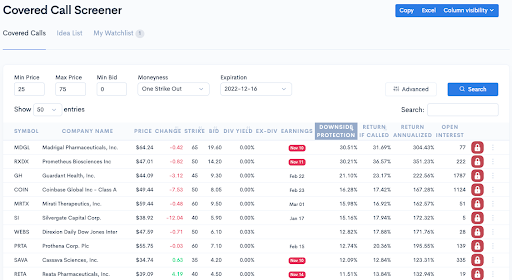Are Covered Calls Safe? Pros & Cons to Consider
Jesse Anderson
Covered calls are one of the most popular option strategies for generating portfolio income without taking on a lot of risks. But that said, that doesn’t mean the strategy is devoid of any risk. You still have to worry about the risk of the underlying stock falling in value and the potential opportunity costs that may arise if it increases in value.
Are Covered Calls Safe?
Let’s look at how covered calls work, two key risks to keep in mind, and strategies to optimize your risk/reward.
Covered calls are a relatively safe option strategy, but there are still a handful of risks to remember. Click To TweetWhat Are Covered Calls?
Covered calls are an options strategy where an investor purchases a long stock position and sells a call option against it. For example, you might buy 100 shares of Acme Co. and simultaneously sell one call option covered by the stock. In the end, you would collect the option premiums immediately and only have to sell the stock if the buyer exercises the option.

The covered call’s option diagram shows the profit-loss profile. Source: The Options Guide
Many investors write call options against stock they already own to generate extra income beyond dividends. They may even use call options to sell their long stock positions by writing options with strike prices equivalent to their take-profit or sell targets. In other cases, investors use buy-write strategies purely to generate maximum income.
Covered Call Risks
Many options strategies involve a significant amount of risk. For example, you can quickly lose your entire investment if you purchase out-of-the-money call options. And worse, you can lose much more than your original investment if you write naked options. Fortunately, best covered calls are less risky than these strategies but keep in mind they’re not risk-free.
Like any long stock position, you can lose money if the stock price drops below the breakeven point (e.g., the purchase price minus any option premiums) since you still own it. For instance, suppose you bought 100 shares of Acme Co. for $10 per share and sold $0.10 call options. If the stock fell to $5.00, you would still lose $490 (e.g., $500 – $10).
On the other hand, if the stock price rises beyond the strike price, there’s also the opportunity cost of missing out on a rally since the buyer would exercise the option. Using the previous example, if the stock price rose to $15 and the strike price for the option was $11, you would miss out on $300 of potential capital gains (e.g., $400 – $100).
Reducing Downside Risk
The biggest risk of a covered call strategy is the underlying stock falling sharply in value. Not surprisingly, the best way to mitigate that risk is to select stocks that are less likely to fall in value. And that typically means looking at fundamental factors, like revenue growth and profitability, and technical characteristics, like beta coefficients.
There are several ways to evaluate opportunities:
- Low beta coefficient. Beta coefficients measure a stock’s historic volatility relative to the S&P 500 index. Readings below 1.0 suggest that a stock is less volatile than the benchmark index and less likely (by historical standards at least) to fall in value dramatically (although option premiums may be lower).
- Debt-to-equity ratios. The debt-to-equity ratio tells you how much debt a company holds relative to its market valuation. Readings above 1.0x could be problematic since the company’s interest payments are likely quite high, and of course, shareholders are usually last to get paid out if a company goes bankrupt.
- Free cash flow yield. Free cash flow is one of the most reliable metrics for investors assessing income and profitability. Free cash flow yield looks at the free cash flow per share divided by the current share price. Higher readings suggest that companies are generating ample cash and are at less risk of solvency problems.
- Downside risk protection. Downside risk protection represents how much downside risk you offset with the option premium. For example, a $1.00 option on a $10 stock offers 10% downside risk protection and might be less risky than a $0.50 option on a $10 stock offering only 5% downside risk protection.
Finally, in addition to these factors, you should mitigate stock-specific risks. That way, if one stock or sector experiences problems, it doesn’t necessarily impact other parts of your portfolio. Most diversified portfolios hold between 20 and 30 stocks, which strikes a good balance between picking good opportunities and remaining diversified.
Managing Rising Prices
The second risk of a covered call strategy is the opportunity cost if the stock price increases. While that’s not a bad problem, since you’re selling at a gain and keeping the option premium as income, you may want to hold on to the stock. For instance, you might want to avoid paying short-term capital gains taxes by selling or believing prices will increase further.
Many beginners make the mistake of selling covered call option with the highest premiums (e.g., a strike price close to the current price). But these are often the options buyers who are most likely to exercise, and you miss out on any potential capital gains above the strike price. So, the first step is to look at the overall picture rather than the premium.

optionDash makes it easy to screen for opportunities by downside protection, if-called return, or other metrics. Source: optionDash
You can look at a couple of different metrics to find the best opportunities:
- If-called return. The if-called return is the annualized net profit of a covered call, assuming the stock price is above the strike price at expiration, and the stock is sold and assigned at expiration. In other words, it’s the worst-case bull scenario.
- If-unchanged return. The if-unchanged return is the annualized net profit assuming the underlying stock remains at its current levels at expiration and remains in your portfolio. You might look at this to see if the option premium alone is worth the return.
If the stock price does rise above the strike price, and you don’t want to sell the stock, you can roll up or roll out the covered call. This process involves closing out the original option with a buy-to-close order and replacing it with another covered call. The only drawback is that the cost to close your original option may be higher than the premium you originally collected.
The Bottom Line
Covered calls are a low-risk option strategy capable of generating income, but that doesn’t mean they’re without risk. Fortunately, you can mitigate downside risk and opportunity costs by looking at factors like downside protection and if-called returns. And tools like optionDash make it incredibly easy to access this data at your fingertips.
Posted in Covered call strategy |